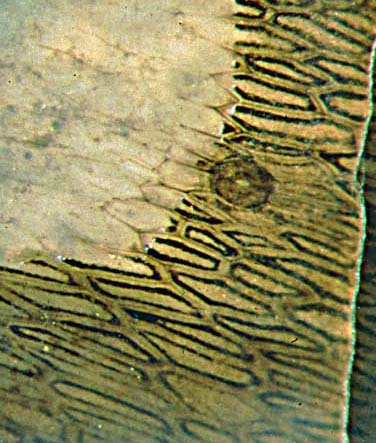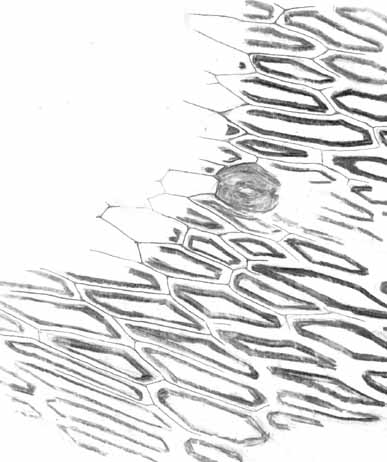Aglaophyton
epidermis outlined
Delicate anatomical structures of fossil plants preserved in chert are
often hardly seen unless the optical contrast is greatly enhanced by
some peculiarity in the processes of decomposition and mineralisation.
The quite uncommon aspect of the epidermis of Aglaophyton
in this photograph may
serve as a conspicuous example of such phenomena. (The common
aspect of the epidermis with stoma in cross-section is seen
in Rhynie
Chert News
2.)


Photograph: Slanting cut of Aglaophyton
shoot with conspicuous surface pattern consisting of peculiar dark
frames inside the epidermis cells.
Drawing: Pattern drawn for better visibility of the
cell walls faintly seen there.
Apparently some dark substance is arranged such
as to make a plane frame within every epidermis
cell, fitting to the shape of the cell and keeping a rather
even distance from the lateral cell walls.
The outer edges of the epidermis cells are faintly
seen as thin lines forming a network of polygonal
meshes right between the dark frames.
In some places where the frames have been cut, a tiny bright spot or
line of reflected light is seen. This means that the polished chert
face is not plane there. Hence one can conclude that the dark matter of
unknown origin is
mechanically different from the surrounding chalcedony.
The frames are enigmatic since usually there is not the slightest
indication of such phenomenon on the surface of silicified plants in
the Rhynie chert. (See Rhynie Chert News
47.)
No explanation is proposed here. Suggestions are welcome.
H.-J. Weiss
2005, emended 2013
 |
 |
6 |





